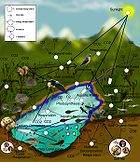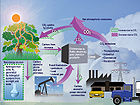- Interspecific competition
-
Interspecific competition, in ecology, is a form of competition in which individuals of different species compete for the same resource in an ecosystem (e.g. food or living space). The other form of competition is intraspecific competition, which involves organisms of the same species.If a tree species in a dense forest grows taller than surrounding tree species, it is able to absorb more of the incoming sunlight. However, less sunlight is then available for the trees that are shaded by the taller tree, thus interspecific competition. Cheetahs and lions can also be in interspecific competition, since both species feed on the same prey, and can be negatively impacted by the presence of the other because they will have less food.
Competition is only one of many interacting biotic and abiotic factors that affect community structure. Moreover, competition is not always a straightforward, direct, interaction. Interspecific competition may occur when individuals of two separate species share a limiting resource in the same area. If the resource cannot support both populations, then lowered fecundity, growth, or survival may result in at least one species. Interspecific competition has the potential to alter populations, communities and the evolution of interacting species. On an individual organism level, competition can occur as interference or exploitative competition.
Direct competition has been observed between individuals, populations and species, but there is little evidence that competition has been the driving force in the evolution of large groups. For example, between amphibians, reptiles and mammals.[1]
Contents
Mechanisms
Interference competition
Interference competition involves direct interactions between individuals such as fighting over limited resources. This form of competition is typically, though not always, detrimental to both individuals and both species involved. These interactions are usually asymmetric with one species having an advantage over the other, resulting in greater loss by one competitor. For example, large predators like canids have a significant size advantage over smaller predators such as foxes or weasels. A violent interaction between two of these species would likely result in victory for the larger predator. The stability of some mammalian carnivore populations is maintained through these conflicts over prey resources.
An example of interference competition in which only one party is negatively affected is allelopathy, in which plants of one species release toxic chemicals that inhibit the germination and survival of other potential competitors. Some animals utilize a similar strategy. For example, algae in the feces of the common frog, Rana temporaria, inhibit the tadpoles of the competing natterjack toad, Bufo calamita.
Exploitative competition
Exploitative competition is a form of competition in which one species either reduces or more efficiently uses a resource and therefore depletes the availability of the resource for the other species. A good example of exploitative competition is found in aphid species competing over the sap in plant phloem. Each aphid species that feeds on host plant sap uses some of the resource, leaving less for competing species. In one study, Fordinae geoica was observed to out-compete F. formicaria to the extent that the latter species exhibited a reduction in survival by 84%.
This type of competition can also be observed in forests where large trees dominate the canopy and thus allow little light to reach smaller competitors living below. These interactions have important implications for the population dynamics and distribution of both species.
Apparent competition
Apparent competition occurs when two or more species in a habitat affect shared natural enemies in a higher trophic level. If two species share a common predator, for example, apparent competition can exist between the two prey items as they attempt to make themselves less available for consumption.[2]
Scramble competition
Scramble competition occurs when a resource is inadequate for the needs of all. Each competitor obtains an equal amount, but never the amount it needs, leading to a depression in population growth.
Consequences
Many studies, including those cited previously, have shown major impacts on both individuals and populations from interspecific competition. Documentation of these impacts has been found in species from every major branch of organism. The effects of interspecific competition can also reach communities and can even influence the evolution of species as they adapt to avoid competition. This evolution may result in the exclusion of a species in the habitat, niche separation, and local extinction. The changes of these species over time can also change communities as other species must adapt.
Competitive exclusion
Main article: Competitive exclusion principleThe competitive exclusion principle states that two species that use the same resource in the same way in the same space and time cannot coexist and must diverge from each other over time in order for the two species to coexist. One species will often exhibit an advantage in resource use. This superior competitor will out-compete the other with more efficient use of the limiting resource. As a result, the inferior competitor will suffer a decline in population over time. It will be excluded from the area and replaced by the superior competitor.
A well documented example of competitive exclusion was observed to occur between Dolly Varden charr (Salvelinus malma) and white spotted char (S. leucomaenis) in Japan. Both of these species were morphologically similar but the former species was found primarily at higher elevations than the latter. Although there was a zone of overlap, each species excluded the other from its dominant region by becoming better adapted to its habitat over time. In some such cases, each species gets displaced into an exclusive segment of the original habitat. Because each species suffers from competition, natural selection favors the avoidance of competition in such a way.
Niche differentiation
Main article: Niche differentiationNiche differentiation is a process by which competitive exclusion leads to differences in resource use. In the previous example, niche differentiation resulted in spatial displacement. In other cases it may result in other changes that also avoid competition. If competition avoidance is achievable, each species will occupy an edge of the niche and will become more specialized to that area thus minimizing competition. This phenomenon often results in the separation of species over time as they become more specialized to their edge of the niche, called niche differentiation. The species do not have to be in separate habitats however to avoid niche overlap. Some species adapt regionally to utilizing different resources than they ordinarily would in order to avoid competition.
There have been several well documented cases in birds where species that are very similar change their habitat use where they overlap. For example, they may consume different food resources or use different nesting habitat or materials. On the Galapagos Islands, finch species have been observed to change dietary specializations in just a few generations in order to utilize limited resources and minimize competition.
In some cases, third party species interfere to the detriment or benefit of the competing species. In a laboratory study, coexistence between two competing bacterial species was mediated by phage parasites.[3] This type of interaction actually helped to maintain diversity in bacterial communities and has far reaching implications in medical research as well as ecology. Similar effects have been documented for many communities as a result of the action of a keystone predator that preys on a competitively superior species.
Local extinction
Main article: Local extinctionAlthough local extinction of one or more competitors has been less documented than niche separation or competitive exclusion, it does occur. In an experiment involving zooplankton in artificial rock pools, local extinction rates were significantly higher in areas of interspecific competition.[4] In these cases, therefore, the negative effects are not only at the population level but also species richness of communities.
Impacts on communities
As mentioned previously, interspecific competition has great impact on community composition and structure. Niche separation of species, local extinction and competitive exclusion are only some of the possible effects. In addition to these, interspecific competition can be the source of a cascade of effects that build on each other. An example of such an effect is the introduction of an invasive species to the United States, Purple-loosestrife. This plant when introduced to wetland communities often outcompetes much of the native flora and decreases species richness, food and shelter to many other species at higher trophic levels. In this way, one species can influence the populations of many other species as well as through a myriad of other interactions. Because of the complicated web of interactions that make up every ecosystem and habitat, the results of interspecific competition are complex and site-specific.
Lotka-Volterra model
The impacts of interspecific competition on populations have been formalized in a mathematical model called the Competitive Lotka–Volterra equations, which creates a theoretical prediction of interactions. It combines the effects of each species on the other. These effects are calculated separately for the first and second population respectively:
In these formulae, N is the population size, t is time, K is the carrying capacity, r is the intrinsic rate of increase and α is the competition coefficient. The results show the effect that the other species has on the species being calculated. The results can be graphed to show a trend and possible prediction for the future of the species. One problem with this model is that certain assumptions must be made for the calculation to work. These include the lack of migration and constancy of the carrying capacities and competition coefficients of both species. The complex nature of ecology determines that these assumptions are rarely true in the field but the model provides a basis for improved understanding of these important concepts.
See also
References
- ^ Sahney, S., Benton, M.J. and Ferry, P.A. (2010). "Links between global taxonomic diversity, ecological diversity and the expansion of vertebrates on land" (PDF). Biology Letters 6 (4): 544–547. doi:10.1098/rsbl.2009.1024. PMC 2936204. PMID 20106856. http://rsbl.royalsocietypublishing.org/content/6/4/544.full.pdf+html.
- ^ Holt, R. D. (1977.) Predation, apparent competition, and the structure of prey communities. Theoretical Population Biology 12: 197-229.
- ^ Brockhurst, M.A., A. Fenton, B. Roulston and P.B. Rainey. 2006. The impact of phages on interspecific competition in experimental populations of bacteria. BMC Ecology6:19.
- ^ Bengtsson J (1989). "Interspecific competition increases local extinction rate in a metapopulation system". Nature 340: 713–715. doi:10.1038/340713a0.
Further reading
- Begon, M., C.R. Townsend and J.L. Harper. 2006. Ecology: From Individuals to Ecosystems. Blackwell Publishing, Malden, MA.
- Connell J.H. (1961). "Factors on the distribution of the barnacle Chthamalus stellatus". Ecology 42 (4): 710–723.
- Giller, P. S. 1984. Community Structure and the Niche. Chapman & Hall, London.
- Holekamp, K.E. 2006. Interspecific competition and anti-predator behavior. National Science Foundation. http://www.nsf.gov/
- Inbar, M., A. Eshel and D. Wool. 1995. Interspecific competition among phloem-feeding insects mediated by induced host-plant sinks. Ecology. 76.5: 1506-1515.
- Shoener T.W. (1983). "Field experiments on interspecific competition". American Naturalist 122: 240.
- Solomon, E. P., Berg, L. R., & Martin, D. W. (2002). Biology, sixth edition. (N. Rose, Ed.). Stamford, CT: Thomson Learning
- Taniguchi Y. and S. Nakano 2000. Condition-Specific Competition: Implications for the Altitudinal Distribution of Stream Fishes. Ecology, 81. 7: 2027-2039
- Weiner, J. 1994. The Beak of the Finch. Cambridge University Press, New York.
External links
- Competition for Territory: The Levins Model for Two Species Wolfram Demonstrations Project — requires CDF player (free)
Categories:- Biological interactions
- Competition
Wikimedia Foundation. 2010.




